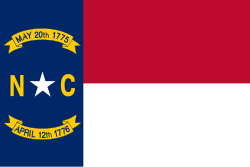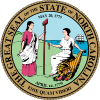
Back Noord-Carolina Afrikaans ኖርዝ ካሮላይና Amharic Carolina d'o Norte AN Norþcarolīna ANG كارولاينا الشمالية Arabic كارولينا الشمالية ARY نورث كارولاينا ARZ Carolina del Norte AST North Carolina suyu Aymara Şimali Karolina Azerbaijani
North Carolina | |
|---|---|
| Nickname(s): The Tarheel State, The Old North State | |
| Motto(s): | |
| Anthem: "The Old North State"[1] | |
 Location of North Carolina within the United States | |
| Country | United States |
| Before statehood | Province of North Carolina |
| Admitted to the Union | November 21, 1789 (12th) |
| Capital | Raleigh |
| Largest city | Charlotte |
| Largest county or equivalent | Wake |
| Largest metro and urban areas | Charlotte |
| Government | |
| • Governor | Josh Stein (D) |
| • Lieutenant Governor | Rachel Hunt (D) |
| Legislature | General Assembly |
| • Upper house | Senate |
| • Lower house | House of Representatives |
| Judiciary | North Carolina Supreme Court |
| U.S. senators | Thom Tillis (R) Ted Budd (R) |
| U.S. House delegation |
|
| Area | |
• Total | 53,819 sq mi (139,391.0 km2) |
| • Land | 48,617.91 sq mi (125,919.8 km2) |
| • Water | 5,201.25 sq mi (13,471.2 km2) 9.66% |
| • Rank | 28th |
| Dimensions | |
| • Length | 501[2] mi (806 km) |
| • Width | 191[3] mi (307 km) |
| Elevation | 700 ft (210 m) |
| Highest elevation | 6,684 ft (2,037 m) |
| Lowest elevation (Atlantic Ocean[4]) | 0 ft (0 m) |
| Population (2024) | |
• Total | |
| • Rank | 9th |
| • Density | 214.72/sq mi (82.90/km2) |
| • Rank | 14th |
| • Median household income | $70,800 (2023)[6] |
| • Income rank | 35th |
| Demonym(s) | North Carolinian (official); Tarheel (colloquial) |
| Language | |
| • Official language | English[7] |
| • Spoken language | As of 2010[8]
|
| Time zone | UTC−05:00 (Eastern[9]) |
| • Summer (DST) | UTC−04:00 (EDT) |
| USPS abbreviation | NC |
| ISO 3166 code | US-NC |
| Traditional abbreviation | N.C. |
| Latitude | 33° 50′ N to 36° 35′ N |
| Longitude | 75° 28′ W to 84° 19′ W |
| Website | nc |
| List of state symbols | |
|---|---|
 | |
 | |
| Motto | Esse quam videri ("To be, rather than to seem")[a] |
| Slogan | First in Flight, First in Freedom (unofficial) |
| Song | "The Old North State" |
| Living insignia | |
| Amphibian | Pine Barrens tree frog |
| Bird | Cardinal |
| Butterfly | Eastern tiger swallowtail |
| Dog breed | Plott Hound |
| Fish | Red drum |
| Flower | Flowering dogwood |
| Insect | Western honey bee |
| Mammal | Eastern gray squirrel |
| Marsupial | Virginia opossum |
| Reptile | Eastern box turtle |
| Tree | Pine |
| Inanimate insignia | |
| Beverage | Milk |
| Color(s) | Red and blue |
| Dance | Carolina shag |
| Food | Scuppernong grape and sweet potato |
| Fossil | Megalodon teeth |
| Gemstone | Emerald |
| Mineral | Gold |
| Rock | Granite |
| Shell | Scotch bonnet |
| Other | Marbled salamander (salamander) |
| State route marker | |
 | |
| State quarter | |
 Released in 2001 | |
| Lists of United States state symbols | |
North Carolina (/ˌkærəˈlaɪnə/ ⓘ KARR-ə-LY-nə) is a state in the Southeastern region of the United States. It is bordered by Virginia to the north, the Atlantic Ocean to the east, South Carolina to the south, Georgia to the southwest, and Tennessee to the west. The state is the 28th-largest and 9th-most populous of the United States. Along with South Carolina, it makes up the Carolinas region of the East Coast. At the 2020 census, the state had a population of 10,439,388.[10] Raleigh is the state's capital and Charlotte is its most populous city. The Charlotte metropolitan area, with an estimated population of 2,805,115 in 2023,[11] is the most populous metropolitan area in North Carolina, the 22nd-most populous in the United States, and the largest banking center in the nation after New York City.[12] The Research Triangle, with an estimated population of 2,368,947 in 2023, is the second-most populous combined metropolitan area in the state, 31st-most populous in the United States,[11] and is home to the largest research park in the United States, Research Triangle Park.
The earliest evidence of human occupation in North Carolina dates back 10,000 years, found at the Hardaway Site. North Carolina was inhabited by Carolina Algonquian, Iroquoian, and Siouan speaking tribes of Native Americans prior to the arrival of Europeans. King Charles II granted eight lord proprietors a colony they named Carolina after the king and which was established in 1670 with the first permanent settlement at Charles Town (Charleston). Because of the difficulty of governing the entire colony from Charles Town, the colony was eventually divided and North Carolina was established as a royal colony in 1729 and was one of the Thirteen Colonies. The Halifax Resolves resolution adopted by North Carolina on April 12, 1776, was the first formal call for independence from Great Britain among the American Colonies during the American Revolution.[13]
On November 21, 1789, North Carolina became the 12th state to ratify the United States Constitution. In the run-up to the American Civil War, North Carolina reluctantly[14] declared its secession from the Union on May 20, 1861, becoming the tenth of eleven states to join the Confederate States of America. Following the Civil War, the state was restored to the Union on July 4, 1868.[15] On December 17, 1903, Orville and Wilbur Wright successfully piloted the world's first controlled, sustained flight of a powered, heavier-than-air aircraft at Kitty Hawk in North Carolina's Outer Banks. North Carolina often uses the slogan "First in Flight" on state license plates to commemorate this achievement, alongside a newer alternative design bearing the slogan "First in Freedom" in reference to the Mecklenburg Declaration and Halifax Resolves.
North Carolina is defined by a wide range of elevations and landscapes. From west to east, North Carolina's elevation descends from the Appalachian Mountains to the Piedmont and Atlantic coastal plain. North Carolina's Mount Mitchell at 6,684 ft (2,037 m) is the highest point in North America east of the Mississippi River.[16] Most of the state falls in the humid subtropical climate zone; however, the western, mountainous part of the state has a subtropical highland climate.[17]
Cite error: There are <ref group=lower-alpha> tags or {{efn}} templates on this page, but the references will not show without a {{reflist|group=lower-alpha}} template or {{notelist}} template (see the help page).
- ^ "Chapter 149". Archived from the original on November 8, 2020. Retrieved May 20, 2022.
- ^ "List of extreme points of US states and territories". Open Street Maps. Retrieved January 31, 2025.
- ^ "List of extreme points of US states and territories". Open Street Maps. Retrieved January 31, 2025.
- ^ a b "Elevations and Distances in the United States". United States Geological Survey. 2001. Archived from the original on October 15, 2011. Retrieved October 24, 2011.
- ^ "United States Census Quick Facts North Carolina". Retrieved January 4, 2025.
- ^ "Household Income in States and Metropolitan Areas: 2023" (PDF). Retrieved January 12, 2025.
- ^ "State language". Ncga.state.nc.cus. p. § 145–12. Retrieved May 23, 2016.
(a) Purpose. English and Spanish are the most common languages of the people of the United States of America and the State of North Carolina. This section is intended to preserve, protect and strengthen the English language, and not to supersede any of the rights guaranteed to the people by the Constitution of the United States or the Constitution of North Carolina. (b) English as the Official Language of North Carolina. English is the official language of the State of North Carolina.
[permanent dead link] - ^ "North Carolina". Modern Language Association. Archived from the original on June 4, 2013. Retrieved August 11, 2012.
- ^ "Time in North Carolina". Current Time UTC. November 3, 2024. Retrieved November 3, 2024.
- ^ Cite error: The named reference
2020CensusQuickFactswas invoked but never defined (see the help page). - ^ a b Cite error: The named reference
PopEstCBSAwas invoked but never defined (see the help page). - ^ Roberts, Deon (November 15, 2018). "Charlotte regains its place as No. 2 U.S. banking center. Will it keep it?". The Charlotte Observer. Archived from the original on November 21, 2018. Retrieved December 1, 2018.
- ^ The Halifax Resolves and the Declaration of Independence Archived May 2, 2021, at the Wayback Machine. National Park Service. Retrieved May 2, 2021.
- ^ "The Road to Secession | NC Historic Sites". historicsites.nc.gov. Retrieved December 23, 2024.
- ^ Richter, William Lee (2009). The A to Z of the Civil War and Reconstruction. Lanham: Scarecrow Press. ISBN 978-0-8108-6336-1. OCLC 435767707.
- ^ "Mount Mitchell State Park". Archived from the original on November 20, 2010. Retrieved November 7, 2010.
- ^ "Western North Carolina Weather and Climate Information". www.hikewnc.info. Archived from the original on September 22, 2022. Retrieved September 22, 2022.

